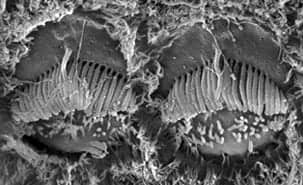A team of researchers led by Michel Cayouette, PhD, made an important discovery that could better explain some inherited forms of hearing loss in humans. Dr Michel Cayouette, a professor Institut de recherches cliniques de Montréal (IRCM) and the University of Montreal, and colleagues have identified a group of proteins crucial for shaping the cellular organ responsible for detecting sounds. The research has been published online (October 14, 2013) by the scientific journal Developmental Cell.

|
|
Aerial surface view of two neighbouring hair cells in the inner ear. On the surface of these developing mouse cells, large stereocilia can be noticed forming a V-shaped brush pointing upwards. The visualization technique used to capture this image is scanning electron microscopy, which allows researchers to see the morphology of the cell surface at high resolution. ©IRCM. Used with permission. |
Hair cells in the inner ear transform sound into electrical impulses before they can be relayed to the brain. On the surface of these cells, microscopic hair-like protrusions known as stereocilia act as specialized sensors to detect vibrations.
“During embryonic development, these stereocilia develop into a characteristic V-shaped brush,” says Dr Cayouette, director of the Cellular Neurobiology research unit at the IRCM. “In addition, all cells orient their brush with the V pointing in the same direction. This polarized organization is critical for sensory function, but remains poorly understood.”
“We studied a group of proteins known to control cell division in the organism and discovered a new role they play in the auditory system,” explains Dr Basile Tarchini, postdoctoral fellow in Dr Cayouette’s laboratory and first author of the study. “We showed that these proteins occupy a specific region at the cell surface to define the exact placement of stereocilia and enable the creation of the V-shaped brush.
“Furthermore, we discovered that one of the proteins is also required for coordinating the orientation of the brushes among neighbouring cells, thereby ensuring that the V formed by each brush points in the same direction,” adds Dr Tarchini. “Our results strongly suggest, for the first time, that this group of proteins could be the link between two important molecular mechanisms: the system responsible for the placement of stereocilia into a V-shaped brush at the cell surface, and the system that orients this V-shaped structure in the surrounding tissue.”
“Recent studies show that mutations in one of the proteins we studied are associated with inherited forms of hearing loss in humans,” concludes Dr Cayouette. “By defining a function for this class of proteins in hair cells, our work helps explain the mechanisms that could cause these conditions.”
The research project was funded by the Canadian Institutes of Health Research (CIHR), as well as Dr Tarchini’s postdoctoral award from the Human Frontier Science Program. For more information, see article summary published online by Developmental Cell.
Source: University of Montreal





